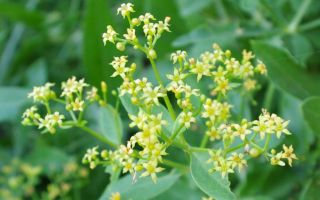Content
- 1 What it looks like and where it grows
- 2 The chemical composition of madder dye
- 3 What helps the useful properties of madder dye
- 4 Preparation and application methods
- 5 Madder dyeing
- 6 Application in cosmetology
- 7 Veterinary use
- 8 Contraindications to the use of madder dye and side effects
- 9 Collection and procurement
- 10 Conclusion
- 11 Reviews of people after treatment with madder dye
Instructions for the use of madder dyeing advises using the plant for inflammation of the kidneys and calculi in the body. The grass effectively regulates the excretory system, but must be handled carefully.
What it looks like and where it grows
Madder (Rubia tinctorum) is a herbaceous perennial from the Madder family with a horizontal woody rhizome and climbing branched shoots. The underground processes of the plant are covered with reddish-brown bark, the stems are tetrahedral, with spiny thorns along the ribs. The dye madder has dense and hard light green leaves of an elliptical or lanceolate shape, located in whorls of 2-6 pieces. Frequent curved spines are also noticeable below the plates and along the edges.
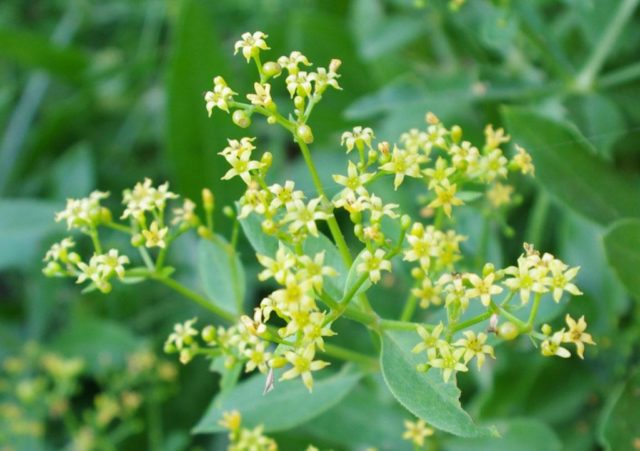
The shoots of the plant begin to develop in mid-May, and from June to August, the perennial brings yellow star-shaped flowers, collected in the apical and axillary semi-umbrellas. From late summer to November, fruits ripen - black juicy drupes up to 1 cm in length.
In its natural form, dye madder is widespread in the Mediterranean, Eastern Europe, Central and Asia Minor. The plant can be found in the southern regions of the European part of Russia and the Caucasus. Marena chooses thickets of bushes and forest edges, abandoned gardens and vineyards for life.
The chemical composition of madder dye
The benefits of dye madder are due to the rich chemical composition of the plant. The roots and aerial parts contain:
- organic acids - malic, citric, tartaric;
- coumarins;
- iridoids;
- vitamin C;
- sugars and amino acids;
- flavonoids;
- tannins;
- triterpenoids;
- minerals and vitamins.
The active substances in the composition of the plant can be both beneficial and harmful. It is necessary to use funds based on perennials with caution, but in small doses they improve well-being and relieve symptoms of diseases.
What helps the useful properties of madder dye
The medicinal plant has many valuable properties. With proper use according to madder recipes:
- has an antispasmodic effect;
- relieves inflammation in prostatitis, cystitis and urethritis;
- dissolves hard calculi in the kidneys and bladder;
- stimulates the outflow of bile;
- improves the condition with gout, rheumatism and osteochondrosis;
- removes deposits from joints;
- promotes resorption of benign tumors of the uterus and ovaries;
- accelerates the healing of wounds and cuts;
- helps with constipation and prevents their recurrence;
- normalizes the spleen;
- regulates the monthly cycle in women;
- fights fungal diseases and eliminates bacteria.
The diuretic effect of madder dye is due to the content in its roots of anthraquinones - purpurin, alizarin, ribiadin, ibericin and others. The listed substances loosen the structure of phosphate and oxalate calculi, stimulate urinary excretion and remove sand and small stones from the kidneys.
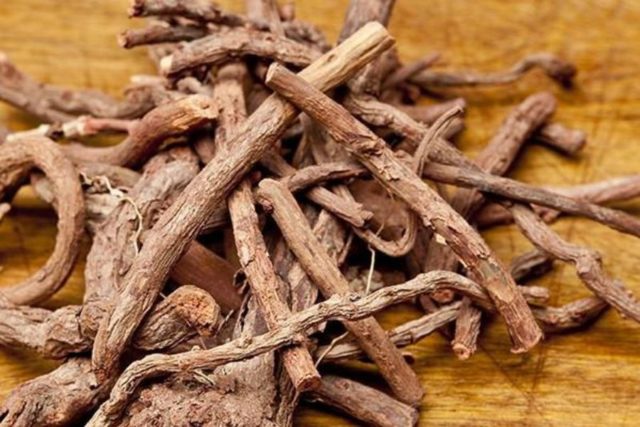
Medicinal properties of the root of the herb madder dye
In folk medicine, the root of the dye madder is especially valued, it contains the most useful substances.
Means based on the underground part of the plant help:
- with jaundice and dropsy;
- with diseases of the spleen;
- with stones in the bladder and kidneys;
- with rickets;
- with dysmenorrhea in women;
- with osteochondrosis, polyarthritis and gout.
Topically, products based on the root of the dye madder can be used to treat rashes and inflammatory skin diseases. Compresses and lotions with plant extract contribute to the rapid resorption of hematomas.
Preparation and application methods
Traditional medicine prepares strong tinctures and water preparations on the basis of dye madder. In addition, the plant extract is available for purchase in pharmacies - a dry concentrate with strong medicinal properties.
Madder tincture
Alcohol tincture of perennial is used for anemia, stones in the ureters and kidneys, for diseases of the spleen. Recipe:
- The dry roots of the plant are crushed to a powder state.
- Pour raw materials with 100 ml of medical alcohol diluted with water in a 1: 1 ratio.
- Put in a closed container in a dark cabinet for two weeks.
- Strain the product through cheesecloth.
It is necessary to take the tincture three times a day at a dosage of up to 20 drops.
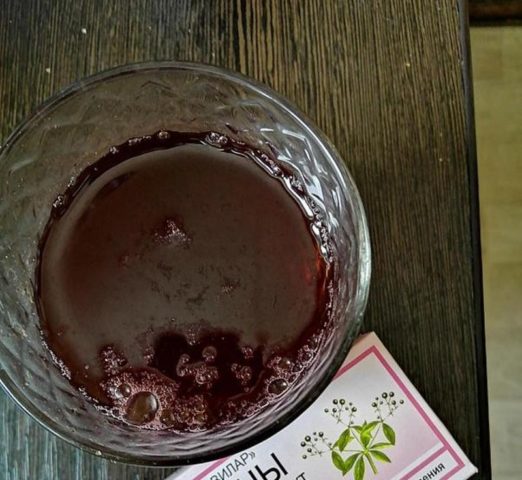
Madder dye extract
The plant extract is available for purchase in tablets and capsules. The drug is used according to the instructions, usually 2-3 tablets are diluted three times a day in 150 ml of warm water.
The extract can be used for kidney stones, nephrolithiasis, urinary tract infections, pain and spasms. The use of the product must be agreed with the doctor, since if used improperly, it can damage the body.
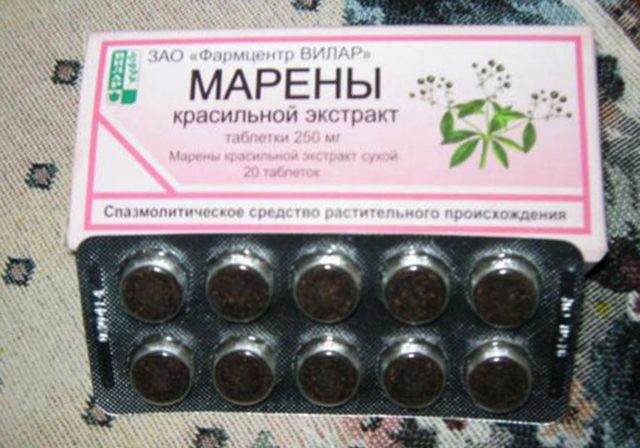
Infusion, decoction of madder dye
Water preparations are prepared from the dried roots of a medicinal plant at home. In particular, for cystitis, urethritis and other inflammatory diseases of the urinary tract, it is recommended to make a healing infusion:
- Pure water in a volume of 200 ml is heated to approximately 85 ° C.
- Pour 20 g of dry madder roots into the liquid.
- Leave under the lid for infusion for three hours.
- They are filtering.
You need to take the infusion on a full stomach, 75 ml.
For external use, you can prepare a decoction. The recipe looks like this:
- About 10 g of crushed perennial roots are poured into 100 ml of liquid.
- Warm up in a water bath for 15 minutes.
- The drug is cooled and filtered.
In a warm broth, a clean cloth is moistened and applied to the joints for rheumatism, polyarthritis and gout. At the same time, the agent can be taken orally for half a glass three times a day.
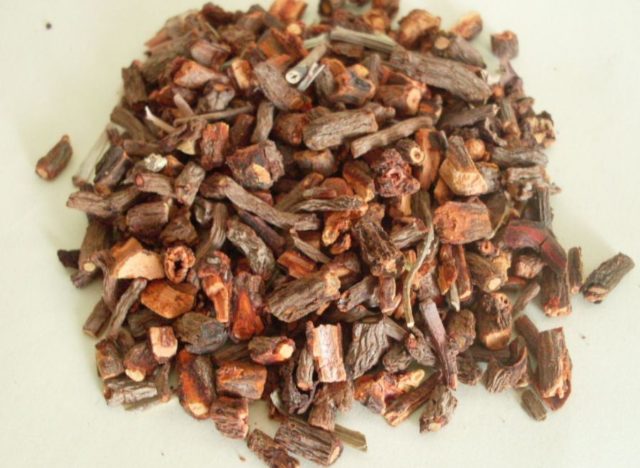
Madder dyeing
Basically, traditional medicine uses dye madder to relieve inflammation in the urinary system and to dissolve stones. There are several proven recipes.
With nephrolithiasis
With stones in one or both kidneys, an infusion of dye madder is beneficial. Prepare it like this:
- Grind the dried root of the plant in the volume of a small spoon.
- Pour raw materials with a glass of boiling water.
- Warm up in a water bath for ten minutes.
- Cool under a lid to a warm temperature and filter.
It is necessary to drink the broth in 100 ml before breakfast and dinner on an empty stomach. Treatment continues for 2-4 weeks until the condition improves.
With edema
The diuretic properties of the dye madder help to get rid of edema and remove not only fluids from the body, but also accumulated toxins. The recipe looks like this:
- The dry roots of the plant are finely chopped.
- Load into a blender and mix into a homogeneous powder.
- Pour into a glass container.
It is necessary to take the product in its pure form three times a day, only 1 g, washed down with warm water.
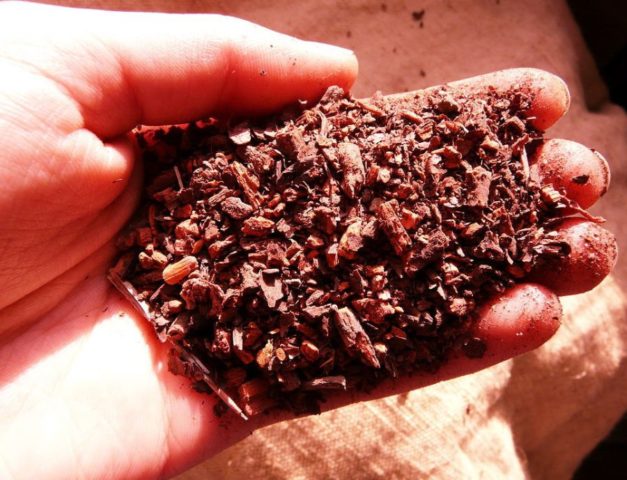
With bronchitis
The dye madder not only removes calculi, but also fights bacterial processes in the respiratory tract. With bronchitis for expectoration, you can prepare the following collection:
- The dye madder is crushed in a volume of 30 g.
- The raw material is mixed with 10 g of naked licorice rhizomes and 15 g of the underground part of the dandelion.
- Measure out two large spoons of the collection and pour 500 ml of boiling water.
- Insist in a thermos or a tightly closed teapot for eight hours.
- Strain before use.
It is necessary to drink the infusion in a glass in the morning and evening on an empty stomach. The remedy not only accelerates recovery, but also strengthens the immune system.
With gallstone disease
Diuretic and antispasmodic properties of the dye madder help with gallstone disease and cholecystitis. The drug is prepared as follows:
- Pour a small spoonful of crushed roots with a glass of cold water.
- Leave at room temperature for eight hours.
- Strain through cheesecloth.
- The remaining cake is steamed with a glass of boiling water for 15 minutes.
- The resulting infusion is filtered and added to the first solution.
You need to take the product twice a day on an empty stomach, 200 ml.
Application in cosmetology
The valuable properties of dye madder are used not only in medicine, but also in cosmetology. The plant has a beneficial effect on the condition of the skin, prevents the development of inflammation and helps get rid of rashes.
Baths with dye madder
If the skin is too dry, prone to irritation, you can take baths with the addition of madder decoction. They do it like this:
- Pour 2 liters of water with 30 g of crushed plant roots.
- Bring the product to a boil on the stove and heat for five minutes.
- Remove from heat and cool.
- Strain and pour into a filled container.
You need to take a bath for about 20 minutes at a water temperature of 37-38 ° C. It is recommended to repeat the procedures twice a week.
Dye madder for acne and blackheads
For problem skin and frequent rashes, you can prepare an ointment based on the plant root. The recipe looks like this:
- The dry root is ground to a powder.
- Measure out a large spoonful of raw materials and combine with 20 g of petroleum jelly.
- Bring to a homogeneous consistency.
The product is applied to problem areas twice a day for 15 minutes, and then washed off with plain water.
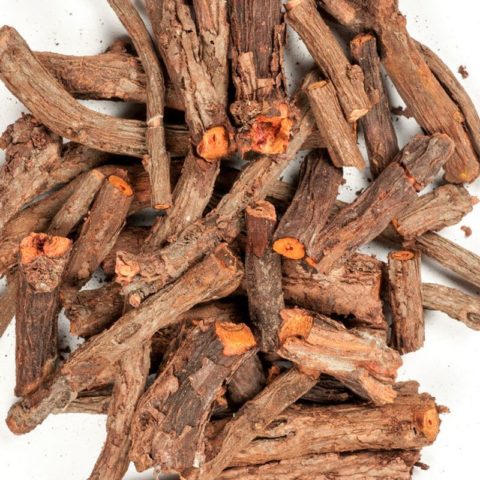
Veterinary use
The diuretic properties of madder are used in the treatment of pets. Dogs and cats in old age often suffer from kidney and ureter stones. To improve the condition of pets, you can use the pharmacy madder extract. Only 1/4 of the tablet is dissolved in 25 ml of water and given to the animal at the rate of 1 ml of the product per 1 kg of body weight.
Contraindications to the use of madder dye and side effects
Indications and contraindications for dye madder are closely related to each other. It is forbidden to use decoctions and infusions of roots:
- with glomerulonephritis;
- with stomach ulcer and acute pancreatitis;
- during pregnancy;
- during breastfeeding;
- with an individual allergy to the plant.
It is important to adhere to the prescription dosages while taking medications. If the safe volumes are exceeded, madder can excessively enhance renal peristalsis and provoke a sharp movement of stones. This will lead to painful colic and bleeding. Also, dye madder root should not be applied for too long without interruption. It contains lucidin, which is capable of provoking oncology when accumulated in the body.
Collection and procurement
For medicinal purposes, the rhizomes of the dye madder are harvested. They need to be collected in early spring before the beginning of the growing season or in late autumn after the stems wilt. During these periods, the underground parts contain the maximum amount of nutrients.
An adult medicinal plant is dug out of the soil entirely with a shovel, shaken off from the soil and the shoots are cut off. It is better not to touch young grass - there are much less valuable substances in it. The roots are washed as quickly as possible under a tap in cool water, dried from moisture and sorted out, removing damaged and rotten shoots. Then the raw materials are laid out in a thin layer on a pallet and placed in a shaded place in the air or in a warm room. If desired, you can also use a dryer at a temperature of 45-50 ° C.
It is necessary to store raw materials of dye madder in linen bags or paper bags in a dark and well-ventilated place. The medicinal plant should not come into contact with bright light. If all conditions are met, the roots will be able to retain healing properties for up to two years.

Conclusion
Instructions for the use of madder dyeing require exactly follow simple rules and use the plant strictly in safe dosages. The herb effectively dissolves deposits in the kidneys and ureters and relieves inflammation, but if used carelessly, it can provoke complications.
Reviews of people after treatment with madder dye

